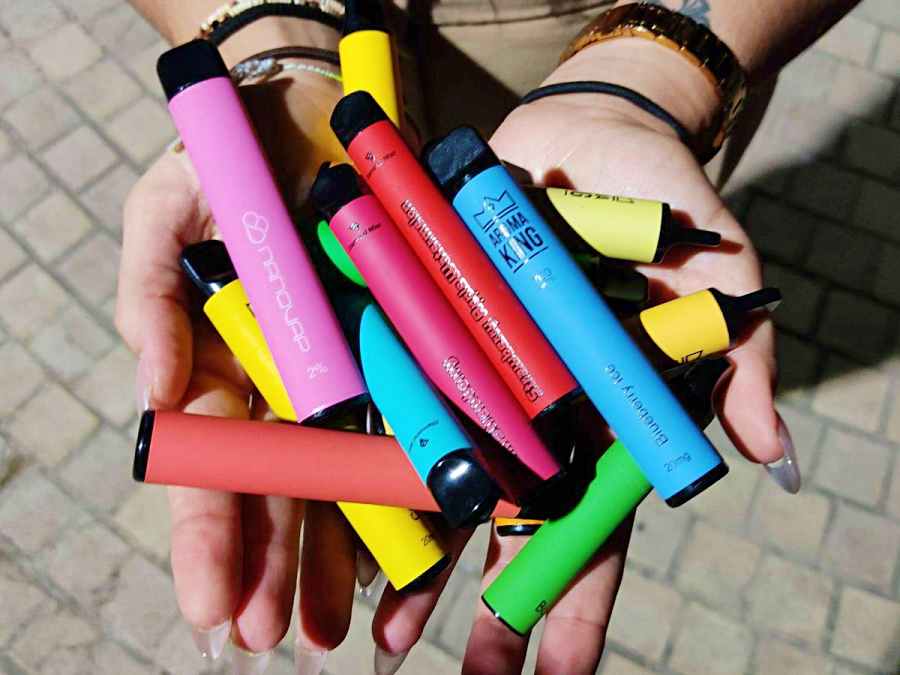Sat 30 September 2023:
The Australian government is cracking down on vaping. Recreational vapes of any type – whether they contain nicotine or not – will be banned from retail sale across Australia after legislation is introduced (though the date is yet to be set).
Rates of teen vaping have been rising rapidly in Australia, from 0.8% of 14- to 17-year-olds describing themselves as a current vaper over the past six months in 2018 to 14.5% in 2023. Among 18- to 24-year-olds, 19.8% have been a current vaper over the past six months.
Teens mainly get vaping products from their friends, retail vaping stores or the internet. Once the government restricts the distribution of vaping products, many will suddenly lose access to supplies.

In anticipation of this loss, people may start stockpiling vapes. But at some stage, they will have a drastic reduction in their use of vaping.
The majority of e-cigarettes contain nicotine, even when they’re not labelled as such. Some vapes tested in Australia contained 900 milligrams of nicotine – the equivalent of the nicotine in almost 100 cigarettes.
So we can expect teenagers who vape will experience nicotine withdrawal symptoms.
What is nicotine dependence and withdrawal?
Nicotine dependence means a person is physically and psychologically addicted to nicotine. This produces a strong desire for, and difficulty controlling, nicotine use.
Young people are at greater risk of nicotine dependence than adults and can develop dependence faster.

Once nicotine-dependent, a person will experience withdrawal symptoms if they reduce or cease their use. These symptoms can include irritability, frustration, or anger; anxiety; difficulty concentrating; increased appetite; restlessness; depressed mood; and insomnia.
The Hooked on Nicotine Checklist is helpful for teens and their parents. It’s a ten-item checklist to assess dependence on smoking cigarettes or vaping, specially designed for adolescents. The higher the score, the less control your teen will have over their nicotine addiction.
Feeling a loss of control can begin after using vapes for only a short time. Some adolescents start showing signs of becoming dependent on nicotine within days of occasionally using it – before they are smoking or vaping daily.

Teens who have a nicotine dependence are likely to experience withdrawal symptoms when they stop vaping. Shutterstock
I don’t even know if my teen vapes …
Nicotine exposure during adolescence can disrupt the brain’s normal development, impacting their mood, impulse control, memory and ability to focus and learn.
If your teen is unusually irritable or has an unexplained low mood, consider the possibility of nicotine withdrawal, particularly after vapes are no longer readily available. Many adolescents are vaping without the adults in the household being aware. Vapes can be hidden in plain sight, as they look like a highlighter pen or USB stick.
Initiating a conversation is sometimes easier when side-by-side, not face-to-face with a young person – for example, when walking together or if your teen is in the car with you. One way to bring the subject up is to ask whether any of their friends are vaping or if they’ve seen it at school. Then gradually move on to whether they have tried it themselves and their usage.
During the conversation listen out for hints that mean your teen could be a heavy user of vaping, such as:
- vaping alone, instead of only socially
- vaping within 30 minutes of waking up in the morning, or
- vaping through the night (this might mean keeping an e-cigarette under the pillow for night-time use).

So how do I help my teen quit?
Once you know your teen is vaping, broach the subject of quitting with them in a non-judgemental way. Try questions like “have you ever tried having a break from them?” and “how did that feel?”
If they are willing to attempt quitting, or are already withdrawing due to reduced access to vaping products, let them know you are there to support them and help is available.
First try counselling and cold turkey
The Quitline or a GP can help with goal setting, such as setting a quit date, making a quit plan and identifying triggers for vaping and strategies to address them.
There are also online tools your teen may like, such as My Quit Buddy, an app that provides practical tips, progress charts and health information to help with quitting.

Nicotine replacement therapy
If counselling alone is not successful, nicotine replacement therapy may help.
Nicotine-replacement therapy is available in a fast-release form (used by mouth via a nicotine inhalator, spray, gum, or lozenges) or a slow-release patch. For someone quitting vaping, fast-release forms are likely to work best.
However, sometimes a teenager might need more than one nicotine-replacement product, called “combination therapy”. Combination therapy is better when the teen is highly dependant on nicotine and has strong and frequent urges to vape.
Be sure to follow the instructions for each product and encourage regular doses so withdrawal symptoms are controlled.

Teens should try counselling and going cold turkey first. Shutterstock
Eighteen year olds can buy nicotine-replacement products without a script at a supermarket or pharmacy. A pharmacist can advise on the correct use.
If your child is aged 12–17, it’s recommended they are first assessed by their GP, who can prescribe nicotine-replacement therapy. A script from a GP may allow access to a subsidised course through the Pharmaceutical Benefits Scheme (PBS).
Aboriginal and Torres Strait Islander youth can get further help from their local Aboriginal health service, which can offer culturally safe support and may also have supplies of nicotine-replacement therapy.
When using nicotine replacement therapy, adherence is critical to successfully quitting. Use it for a minimum of eight weeks and preferably 12 weeks to avoid relapse.
GPs can also prescribe nicotine liquid (non-flavoured) for a refillable e-cigarette. But clinical guidelines recommend discouraging vaping because of their ongoing addictive nature because they’re a gateway for smoking tobacco.
Teens who vape are three times more likely to take up smoking. So addressing your teen’s vaping is an important preventative step for both smoking and vaping in future.
Authors:
![]()
Gillian Sandra Gould
Professor in Health Equity, Southern Cross University
Gillian Gould is Professor in Health Equity and recently completed an NHMRC Translating Research into Practice (TRIP) Fellow, co-funded by Cancer Institute NSW, at Southern Cross University. She is an active vocationally registered GP with >30 years’ experience, and a Tobacco Treatment Specialist.
Her clinical work is at the Coffs Harbour Refugee Health Clinic which she co-founded in 2006. Previously a founding academic at UNSW Faculty of Medicine Rural Clinical School 2002-11, Head of Campus Rural Clinical school, senior research fellow.
Gould is committed to supporting regional research.
Gould’s focus had been to improve tobacco smoking risks for Indigenous Australians. She co-developed, over a decade, multiple innovative strategies to tackle smoking with Aboriginal communities. Gould co-developed and led the first national trial for Indigenous pregnant smokers – SISTAQUIT (Supporting Indigenous Smokers To Assist Quitting) (Global Alliance for Chronic Disease (GACD)/NHMRC).
This intervention was followed by an implementation phase called iSISTAQUIT in 40 health services supported by major funding from the Federal Department of Health. Gould will take iSISTAQUIT to full national scale up in 2023-2026 and explore the translation to Indigenous populations globally. Impressively, Gould leads this key intervention from formative research to national scale in less than 7 years. The intervention aimed at health providers in antenatal care has potential to Close the Gap on Indigenous Smoking and improve the lives of Indigenous children.
Gould is currently collaborating to design multi-behavioural approaches to aid refugees to address smoking, nutrition, alcohol and physical activity.
Gould is also qualified in arts therapy (MA), drama, and media and uses her expertise in both medicine and the arts to excellent effect through innovative media.
______________________________________________________________
![]()
Karen McFadyen
Research Fellow, Faculty of Health, Southern Cross University
Karen is currently working on smoking and vaping cessation projects – particularly in the provision of training and materials to aid health professionals and organisations to support smoking cessation in pregnant Indigenous women. She is experienced in staff wellbeing, workplace health and productivity interventions and research projects. Karen is passionate about improving lives through the provision of clear, useful information combined with small changes in behaviour. She holds postgraduate qualifications in business management and marketing and enjoys outdoor activities with her family, reading, and taking long walks along the beach.
______________________________________________________________
![]()
Marilyn Clarke
Senior Research Fellow, Southern Cross University
O&G specialist (FRANZCOG)
Senior Research Fellow, Southern Cross University and La Trobe University
______________________________________________________________
FOLLOW INDEPENDENT PRESS:
TWITTER (CLICK HERE)
https://twitter.com/IpIndependent
FACEBOOK (CLICK HERE)
https://web.facebook.com/ipindependent
Think your friends would be interested? Share this story!





